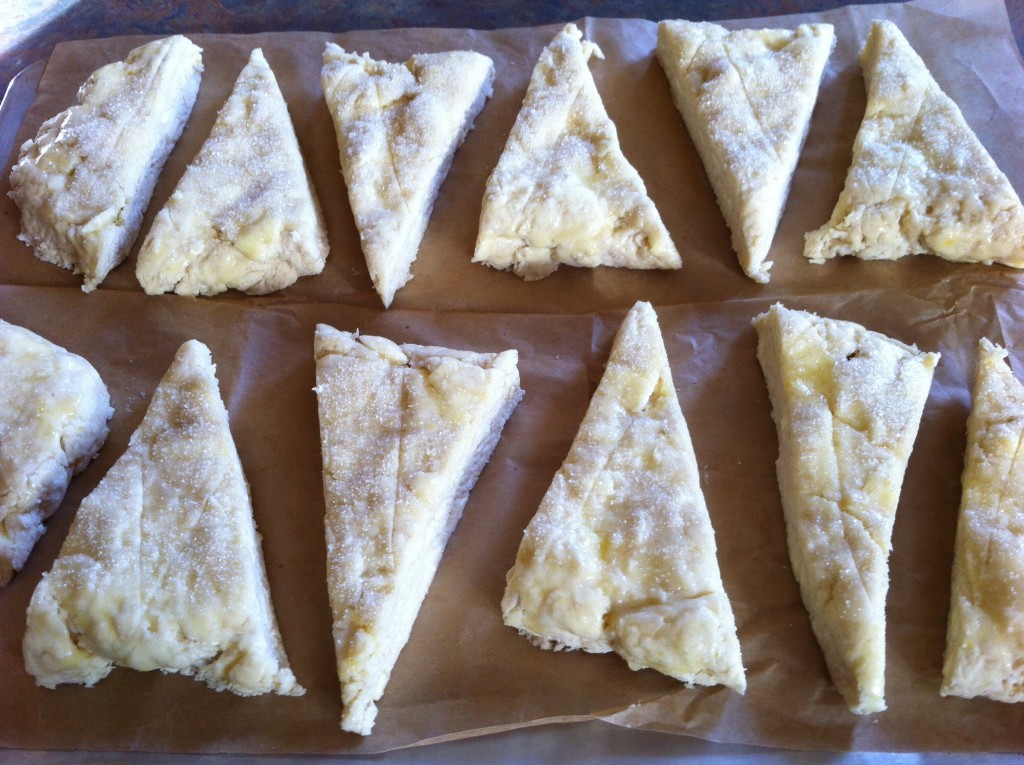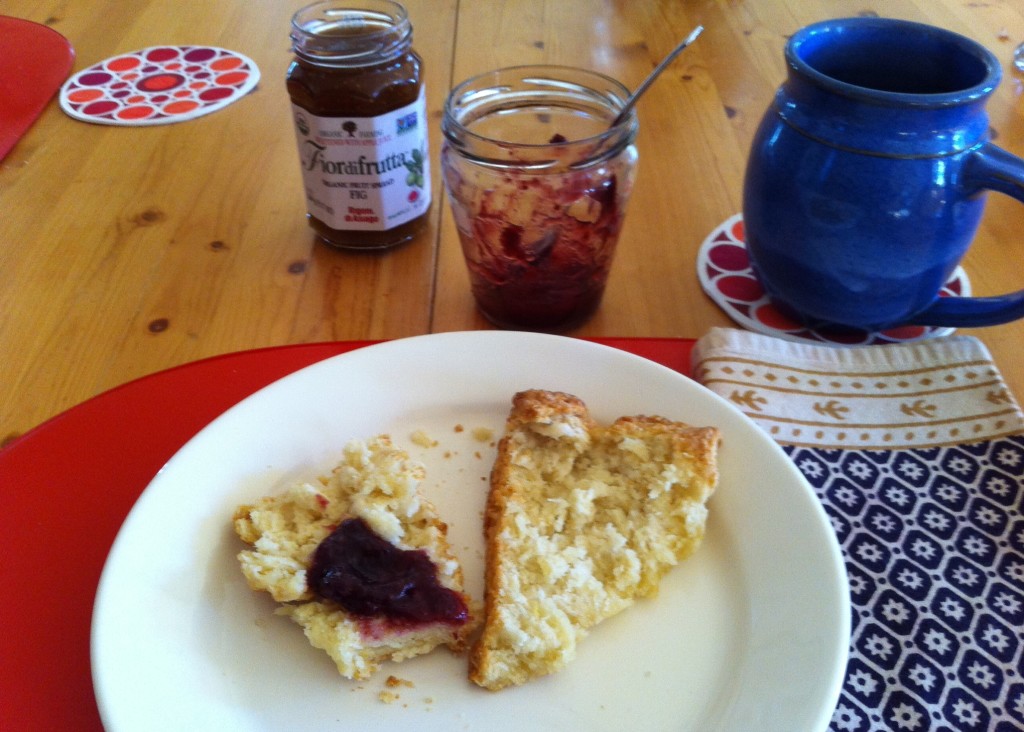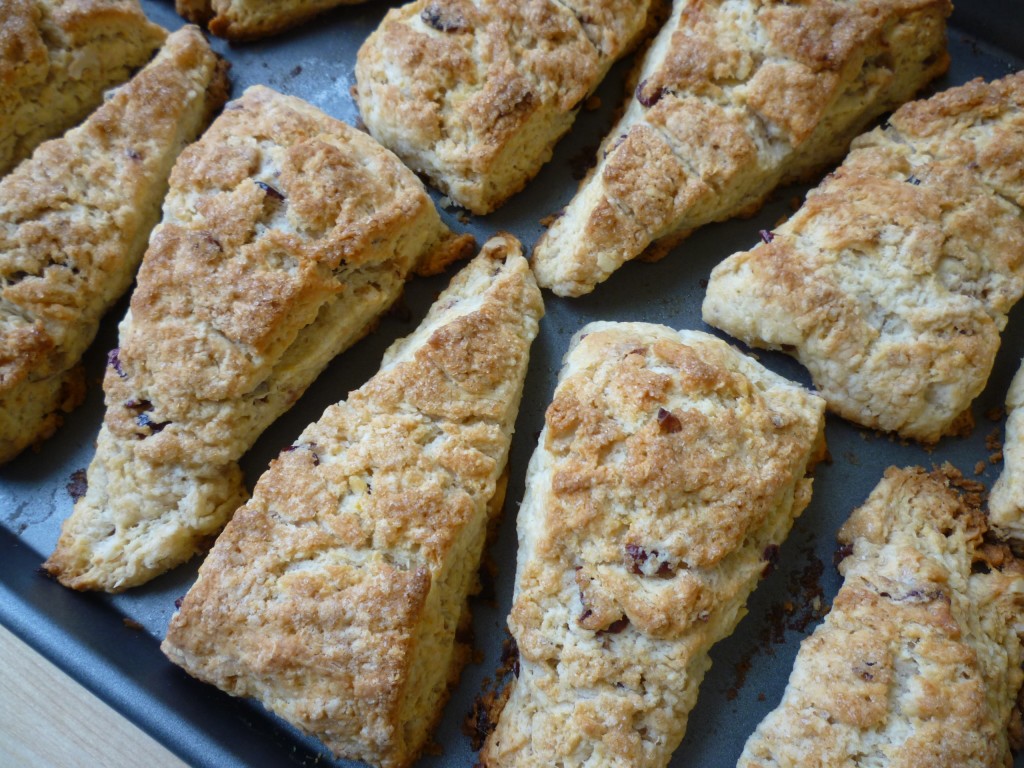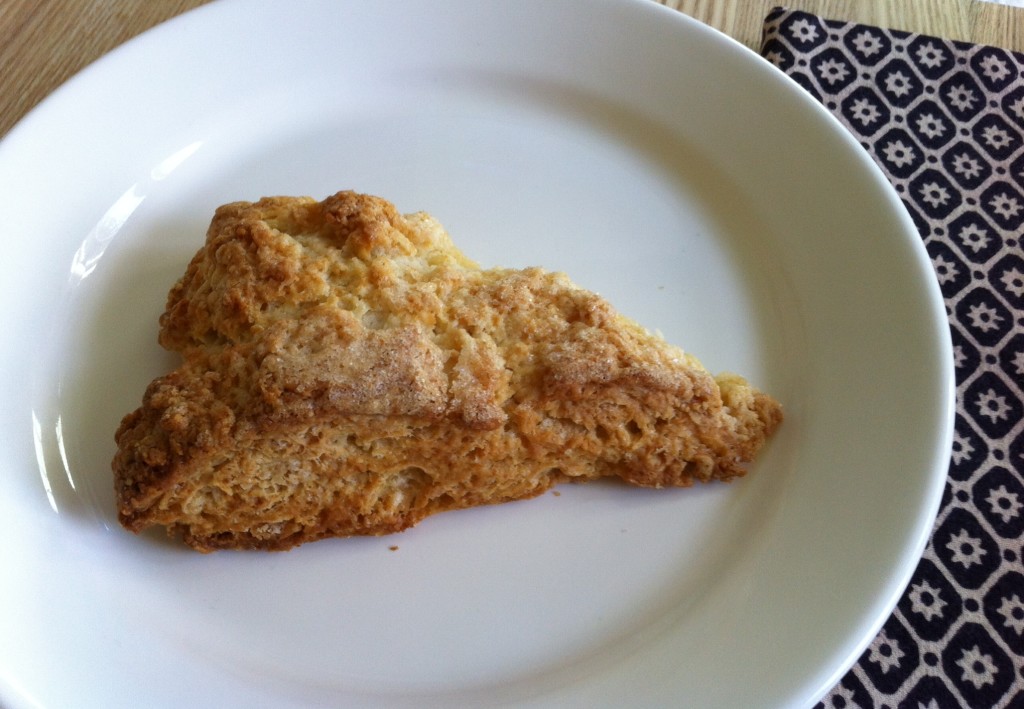My newest scone recipe discovery comes from pastry chef Elizabeth Prueitt’s book Tartine which she co-authored with her husband, the baker Chad Robertson. This recipe can be varied – as they do in their famous Tartine Bakery & Cafe in San Francisco – using different types of dried and fresh fruit.

In general, it’s not hard to make scones but in order to have great texture it’s worth it to pay attention to what she says about scones: “… their delicate and flaky texture [is] the result of carefully cutting in the butter and using a light hand to mix in the other ingredients”.
I got the flakiest and most tender scones every time I made these scones using this recipe. Last time I left out the recommended currants and the scones were equally fantastic. They are the best when served immediately after they come out from the oven.
all-purpose flour – 4¾ cups (680 g) + extra for dusting
granulated sugar – ½ cup (100 g)
baking powder – 1 teaspoon (15 ml)
baking soda – ¾ teaspoon (3¾ ml)
salt – 1¼ teaspoon (6¼ ml)
unsalted butter, very cold – 1 cup + 1 tablespoon (255 g)
lemon zest, grated – 1 teaspoon (5 ml)
Zante currants (optional) – ¾ cup (100 g)
buttermilk – 1½ cups (375 ml)
for the topping
unsalted butter, melted – 3 tablespoons (45 ml)
granulated sugar – for sprinkling the top
Preheat the oven to 400°F (200°C). Line a baking sheet with parchment paper. If using the currants, first place them in a small bowl with warm water, cover, and let plump for 10 minutes (while you are making the dough), then drain them well.
Sift the flour, baking powder, and baking soda into a big bowl, then mix in the sugar and the salt. Cut the butter into small cubes, add to the dry ingredients, and using a pastry blender make a coarse crumble with visible pea-sized lumps of butter in it. (Alternatively, you can use a stand mixer fitted with the paddle attachment to make the dough.) Stir in the buttermilk at once together with the lemon zest and currants (if using). Mix gently with a wooden spoon (or on low speed if using a mixer). If the mixture looks dry, add a little more buttermilk to it.
Turn the dough out onto a lightly floured work surface. Using your hands, pat into a rectangular shape, approximately 18 inches (45 cm) long, 5 inches (12.5 cm) wide, and 1½ inches (3.75 cm) thick. Brush the top with the melted butter and sprinkle with granulated sugar. Cut the dough into 12 triangles and place them on the baking sheet. Bake for 25-35 minutes until golden.
Note
Zante currants are dried tiny grapes. You can also use other small dried fruit (blueberries, raspberries, raisins) or bigger ones that were cut into small pieces (strawberries or even peaches). If you use fresh fruit, first freeze them in a single layer before adding them to the dough.
A legújabb édes pogácsa receptem a „Tartine” című szakácskönyvből való, amelynek szerzői Elizabeth Prueitt cukrász és férje Chad Robertson, az Amerika-szerte jól ismert pék. Híres San Francisco-i „Tartine” nevű pékségükben gyakran variálják ezt a receptet oly módon, hogy különféle szárított vagy friss gyümölcsöt használnak. Édes pogácsát igazán nem nehéz sütni (ami valójában nem is pogácsa, de egyelőre nem találtam jobb magyar kifejezést az angol „scone” szóra), de nem árt odafigyelni arra, amit Elizabeth mond. Akkor lesznek a pogácsák nagyon porhanyósak és levelesek, ha a lisztben óvatosan vagdaljuk apróra a vajat és a hozzávalókat könnyedén keverjük össze. Valóban, ha erre odafigyelek és ezt a receptet használom, mindig kitűnő az eredmény. Legutóbb kifelejtettem a mazsolát, de ennek ellenére fantasztikus pogácsákat sütöttem. Frissen, rögtön melegében a legfinomabbak.
simaliszt – 680 g + kevéske a deszka szórásához
kristálycukor – 100 g
sütőpor – 1 teáskanál (15 ml)
szódabikarbóna – ¾ teáskanál (3¾ ml)
só – 1¼ teáskanál (6¼ ml)
fagyos vaj – 255 g
reszelt citromhéj – 1 teáskanál (5 ml)
korinthoszi mazsola (elhagyható) – ¾ cup (100 g)
író – 375 ml
a pogácsa tetejére
olvasztott vaj – 3 evőkanál (45 ml)
kristálycukor – tetszés szerint
A sütőt előmelegítjük 200°C-ra, s egy tepsit kibélelünk sütőpapírral. A mazsolát egy kis tálba tesszük, felöntjük meleg vízzel, 10 percig állni hagyjuk, majd jól lecsepegtetjük. Ezalatt elkészítjük a tésztát.
A lisztet, a sütőport és a szódabikarbónát egy nagy tálba szitáljuk. Belekeverjük a cukrot és a sót. A vajat kis kockákra vágjuk, a száraz hozzávalókhoz adjuk és óvatosan (két kés segítségével) morzsásra vagdaljuk, de borsó nagyságú vajdarabkákat hagyunk benne. (Természetesen robotgéppel is készíthetjük a tésztát). Egyszerre beleöntjük az írót, beleszórjuk a reszelt citromhéjat és a mazsolát, s fakanállal lazán összekeverjük. Ha a tésztát száraznak találnánk, még egy kis írót adunk hozzá. Lisztezett deszkára borítjuk és kezünkkel körülbelül 45 cm hosszú, 12,5 cm széles és 3,5 cm magas téglalappá lapogatjuk. Tetejét megkenjük az olvasztott vajjal, s megszórjuk tetszés szerinti mennyiségű kristálycukorral. A tésztát 12 darab háromszögre vágjuk és a tepsire rendezzük. 25-35 perc alatt aranyszínűre sütjük .
Megjegyzés
A korinthoszi mazsola, aminek az amerikai angolban „Zante currant” a neve, picurka, mag nélküli, feketeszemű aszalt szőlő. Bármilyen apró szárított gyümölccsel helyettesíthetjük (áfonya, málna, mazsola), de nagyobb gyümölcs is megfelel (eper, őszibarack), csak vágjuk kis darabkákra. Ha friss gyümölcsöt használunk, előbb gyorsfagyasztjuk, s csak utána adjuk a pogácsatésztához.









